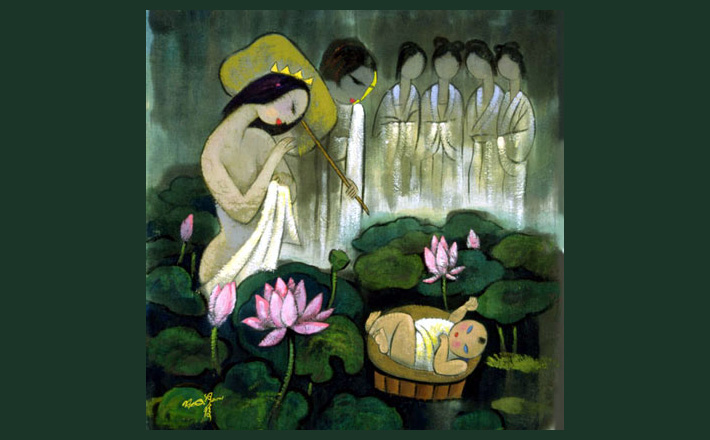Commentary on Isaiah 51:1-6
Although the lectionary excludes the last two verses of this passage (verses 7-8), they are clearly related (see their repetitions of verses 1 and 6).
Just as the Matthew passage for the day deals with identity, so does this short passage from the exilic section of the book of Isaiah.
For Matthew the question was, “Who do people say that the Son of Man is?” (16:13). In the Isaiah passage it is not the leader whose identity is under scrutiny, but the people themselves, as the prophet asks them to look to their own heritage. Although this passage points to several moments in Israel’s story, the most overt reference is to Abraham and Sarah.
Given this founding couple’s prominence in Genesis, one would think recollections of them would be spread throughout the biblical story, but actually they are not. In fact, this is Sarah’s only appearance in the Hebrew Bible outside of Genesis. Even in Exodus through Deuteronomy, Abraham’s name only appears in the formulaic “Abraham, Isaac, and Jacob.” Then he virtually disappears until the early exilic book of Ezekiel when, in a saying reminiscent of this one, Ezekiel criticizes those left in the land who say, “Abraham was only one man, yet he got possession of the land; but we are many; the land is surely given us to possess” (Ezekiel 33:24).
References to the Garden of Eden, another foundational story of Genesis, are similarly scarce throughout the biblical account, and only reappear in Ezekiel. See the strangely similar account concerning a prince of Tyre in Ezekiel 28, especially verse 13, and references to “the garden of God” and “the trees of Eden” in chapter 31 and in 38:35.
Such late remembrances of Abraham, Sarah, and Eden indicate that these Genesis accounts are not necessarily as old as their prominence in the Bible’s first pages suggests. Rather, they are newly known in exilic times. Ezekiel seems to know a version of these stories, and Second Isaiah, at the end of the Babylonian period, refers to them as well, at a time when Judah’s identity as a nation is being reconstituted.
The story of Abraham, who once traveled the road from Ur in Babylonia to Canaan, features questions of land, progeny, and future, and the raising of hope against all hope. Though the Judeans were once subjects of a monarchy centered on Jerusalem, through Abraham’s story they are encouraged to view themselves as a family, a clan of people whose existence preceded the Davidic dynasty by many centuries, and even preceded their tenure in the land.
Not only this, but they are to think of themselves as children of promise, envisioned long beforehand by a God who singled out one unpromising couple for blessings. If Abraham and Sarah could become parents of many, even the depleted generation of exile could regain its footing and become many.
The Eden story also features themes important in Babylonian times, particularly the transgression of divine command, sin, and exile from an original land. Like the land of “thorns and thistles” outside the garden (Genesis 3:18), Judah is described here as a wilderness. But in a dramatic reversal the prophet foresees that it will become once again a fruitful garden.
Reversals of Lamentations intertwine with the imagined return to the garden. A lament most likely composed shortly after Jerusalem’s destruction by the Babylonians had said repeatedly that Jerusalem had no one to comfort her (1:2, 9, 16, 17, 21).
But Second Isaiah’s poetry repeats over and over, beginning in the first verse (40:1) and again in 49:13, that God will bring comfort. This theme, expressed here as “the Lord will comfort Zion; he will comfort all her waste places” (51:3), will reappear a few verses later in 51:12, and most decisively in 52:9.
If the first three verses keep the past and past words firmly in view, the rest of this passage echoes, and sometimes culminates, themes found within Second Isaiah’s own poetry: joy and gladness (verse 3; see 35:10; 51:11), Jerusalem’s ruins (verse 3; see 44:26; 49:19; 52:9); God’s teaching (verses 4, 7; see 42:4, 21, 24); justice/judgment (verse 4; see 40:14, 27; 41:1; 42:1, 3, 4; 49:4; 50:8; 53:8; 54:17); light (verse 4; see 42:6, 16; 45:7; 49:6); tsedek (righteousness/deliverance/victory, verses 1, 5, 7; see 41:2, 10; 42:6, 21; 45:8, 13, 19, 25); coastlands/islands (verse 5; see 40:16; 41:1, 5; 42:4, 10, 12, 15; 49:1); salvation (verses 6, 8; see 49:6, 8; 52:7,10); and especially God’s arm (verse 5), a thread that begins in 40:10, 11, reappears in 48:14, and will become particularly prominent in what follows in 51:9, 52:10, and 53:1. In short, these verses seem to be a tour de force of Second Isaian vocabulary, knitting together themes from throughout the book.
So what can we make of all this? Studies of modern music show that repetition makes the heart grow fonder. This is why songs we may not like at first “grow” on us over time, and why a song we have heard ninety-nine times can yield new discoveries even on the hundredth hearing.
Second Isaiah seems to recognize the beauty of the known, in fact to savor it, even to the point of joining with popular words the poet wishes to dispute, such as the lament. Repeating his own words over and over as a complex refrain, and repeating even newfound founding stories as if they were ancient, the prophet reinforces the encouraging message of redemption for a people who need a new song to sing, a song of hope and deliverance.


August 24, 2014